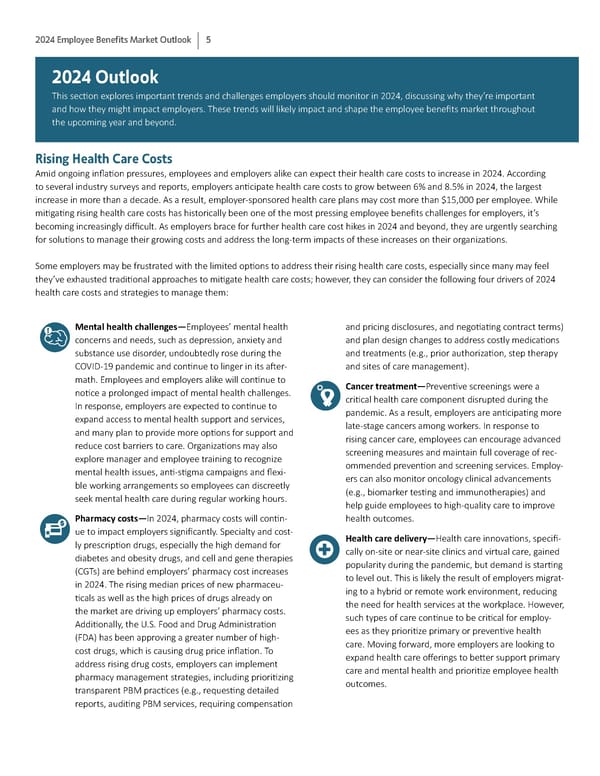2024 Employee Benefits Market Outlook 5 2024 Outlook This sec琀椀on explores important trends and challenges employers should monitor in 2024, discussing why they’re important and how they might impact employers. These trends will likely impact and shape the employee bene昀椀ts market throughout the upcoming year and beyond. Rising Health Care Costs Amid ongoing in昀氀a琀椀on pressures, employees and employers alike can expect their health care costs to increase in 2024. According to several industry surveys and reports, employers an琀椀cipate health care costs to grow between 6% and 8.5% in 2024, the largest increase in more than a decade. As a result, employer-sponsored health care plans may cost more than $15,000 per employee. While mi琀椀ga琀椀ng rising health care costs has historically been one of the most pressing employee bene昀椀ts challenges for employers, it’s becoming increasingly di昀케cult. As employers brace for further health care cost hikes in 2024 and beyond, they are urgently searching for solu琀椀ons to manage their growing costs and address the long-term impacts of these increases on their organiza琀椀ons. Some employers may be frustrated with the limited op琀椀ons to address their rising health care costs, especially since many may feel they’ve exhausted tradi琀椀onal approaches to mi琀椀gate health care costs; however, they can consider the following four drivers of 2024 health care costs and strategies to manage them: Mental health challenges—Employees’ mental health and pricing disclosures, and nego琀椀a琀椀ng contract terms) concerns and needs, such as depression, anxiety and and plan design changes to address costly medica琀椀ons substance use disorder, undoubtedly rose during the and treatments (e.g., prior authoriza琀椀on, step therapy COVID-19 pandemic and con琀椀nue to linger in its a昀琀er- and sites of care management). math. Employees and employers alike will con琀椀nue to Cancer treatment—Preven琀椀ve screenings were a no琀椀ce a prolonged impact of mental health challenges. cri琀椀cal health care component disrupted during the In response, employers are expected to con琀椀nue to expand access to mental health support and services, pandemic. As a result, employers are an琀椀cipa琀椀ng more late-stage cancers among workers. In response to and many plan to provide more op琀椀ons for support and rising cancer care, employees can encourage advanced reduce cost barriers to care. Organiza琀椀ons may also screening measures and maintain full coverage of rec- explore manager and employee training to recognize ommended preven琀椀on and screening services. Employ- mental health issues, an琀椀-s琀椀gma campaigns and 昀氀exi- ers can also monitor oncology clinical advancements ble working arrangements so employees can discreetly seek mental health care during regular working hours. (e.g., biomarker tes琀椀ng and immunotherapies) and help guide employees to high-quality care to improve Pharmacy costs—In 2024, pharmacy costs will con琀椀n- health outcomes. ue to impact employers signi昀椀cantly. Specialty and cost- Health care delivery—Health care innova琀椀ons, speci昀椀- ly prescrip琀椀on drugs, especially the high demand for diabetes and obesity drugs, and cell and gene therapies cally on-site or near-site clinics and virtual care, gained popularity during the pandemic, but demand is star琀椀ng (CGTs) are behind employers’ pharmacy cost increases to level out. This is likely the result of employers migrat- in 2024. The rising median prices of new pharmaceu- ing to a hybrid or remote work environment, reducing 琀椀cals as well as the high prices of drugs already on the market are driving up employers’ pharmacy costs. the need for health services at the workplace. However, such types of care con琀椀nue to be cri琀椀cal for employ- Addi琀椀onally, the U.S. Food and Drug Administra琀椀on ees as they priori琀椀ze primary or preven琀椀ve health (FDA) has been approving a greater number of high- care. Moving forward, more employers are looking to cost drugs, which is causing drug price in昀氀a琀椀on. To address rising drug costs, employers can implement expand health care o昀昀erings to be琀琀er support primary care and mental health and priori琀椀ze employee health pharmacy management strategies, including priori琀椀zing outcomes. transparent PBM prac琀椀ces (e.g., reques琀椀ng detailed reports, audi琀椀ng PBM services, requiring compensa琀椀on
 2024 Employee Benefits Market Outlook Page 4 Page 6
2024 Employee Benefits Market Outlook Page 4 Page 6